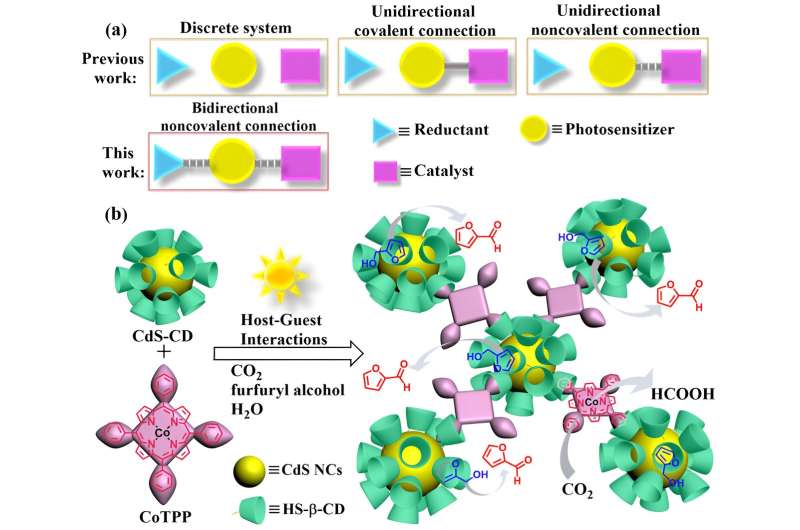This article has been reviewed according to Science X's editorial process and policies. Editors have highlighted the following attributes while ensuring the content's credibility:
fact-checked
trusted source
proofread
Bidirectional host-guest interactions promote selective photocatalytic carbon dioxide reduction

The construction of highly efficient artificial photosynthesis systems to convert CO2 into versatile chemicals is a sustainable pathway to alleviate global warming and the ongoing energy crisis. To bring artificial photosynthetic technologies towards practical applications, a carbon cycle of CO2 reduction coupled with H2O oxidation is considered to be an ideal approach to convert solar energy into chemical energy, as performed by photosynthesis in nature.
However, the significant kinetic barrier for the water oxidation reaction limits the photocatalytic efficiency of the CO2 reduction. Therefore, additional electron sacrificial agents have been employed as electron donors to promote the photocatalytic reduction of CO2.
However, the consumption of sacrificial agents is not only economically unfeasible, but also wastes the oxidation capacity of the photogenerated holes. In this regard, coupling the CO2 reduction process with oxidation of organics to yield value-added chemicals is a promising strategy for practical application. Moreover, if the organics are derived from biomass, only virtually renewable feedstocks are consumed.
To improve the electron transfer efficiency in the photocatalytic system, researchers have attempted to shorten the distance between the catalyst and the photosensitizer by building a 'bridge' between them. However, complicated synthetic procedures are required in addition to precious metal-based catalysts, and the possible breakage of covalent bonds during the electron transport process may result in an irreversible loss in the stability and activity of the system.
Recently, a research team led by Prof. Tong-Bu Lu from Tianjin University of Technology, China, reported the bidirectional host-guest interactions between the photosensitizer and the catalyst/reactant, in which the catalyst and the reactant were concurrently gathered on the surface of the photosensitizer.
The direct contact between the photosensitizer and the catalyst/reactant shortens the transmission distance of photogenerated carriers, thus can dramatically boost the photocatalytic CO2 reduction to HCOOH, with a yield of 1610 μmol g-1 h-1 and a selectivity of 96.5%. Meanwhile, the photogenerated holes in CdS can also be quickly annihilated by β-CD bonded furfuryl alcohol, achieving a furfural yield of 1567 μmol g-1 h-1 and > 99% selectivity.
This work opens a new route to the facile construction of highly efficient artificial photosynthesis systems for practical application. The results were published in Chinese Journal of Catalysis.
More information: Wen Zhang et al, Bidirectional host-guest interactions promote selective photocatalytic CO2 reduction coupled with alcohol oxidation in aqueous solution, Chinese Journal of Catalysis (2023). DOI: 10.1016/S1872-2067(23)64509-7
Provided by Chinese Academy of Sciences





















